Gelcoat, known for its protective properties and glossy finish, is a common choice for boat hulls and recreational vehicles. However, over time, exposure to sun and weather can take a toll on its appearance, leading many to ask the question: “Can you paint over gelcoat?” This article aims to explore that question in depth, examining the considerations, steps, and potential pitfalls of painting over a gelcoat surface.
Gel Coat Boat Repair vs a Paint Job
When it comes to maintaining the aesthetics and durability of a boat, choosing between a gel coat boat repair and a paint job is a common dilemma. Both approaches have their unique advantages and potential drawbacks.
It involves re-applying the gel coat layer, which is essentially a high-quality polyester resin with strong resistance against water absorption and UV damage.On the other hand, a paint job might be a more cost-effective and quicker solution. High-quality marine paints can offer a vibrant, glossy finish that’s visually comparable to gel coats. Paints also come in a wider variety of colors, allowing for more customization.
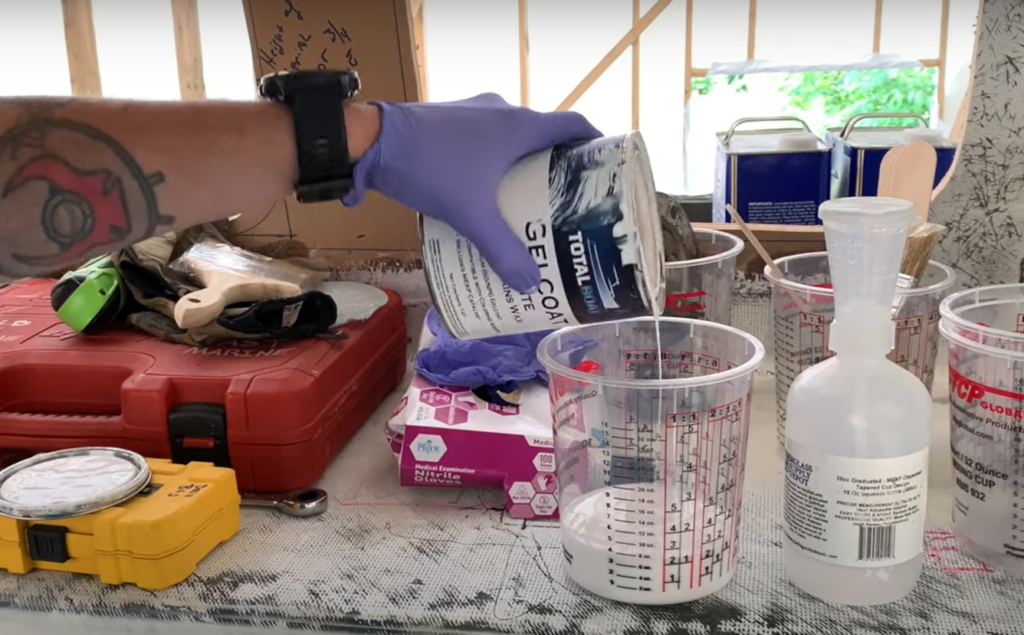
In conclusion, the decision between a gel coat repair and a paint job relies heavily on a boat owner’s specific needs, budget, and aesthetic preferences.
How to Paint Gelcoat
Before painting over a gelcoat, there are several steps to follow.
- Preparation: Start by thoroughly cleaning the surface using a gentle detergent and water. Make sure to rinse it well and allow it to fully dry.
- Sanding: After drying, use 220-grit sandpaper to remove gloss and create a surface for the primer to adhere to.
- Priming: Apply a high-quality marine primer for a solid paint base. Let it dry as instructed by the manufacturer.
- Sanding again: Once the primer is dry, gently sand it with 400-grit sandpaper to smooth any rough spots.
- Applying Paint: Select a high-quality marine paint and apply it in thin, even coats. Ensure each coat is fully dry before applying the next.
- Sealing: To complete the process, carefully apply a clear coat sealer. This step not only safeguards the paint job but also imparts a lustrous and glossy finish, elevating the overall appearance. [1]
Restoring the Original Finish Instead of Painting Over Gelcoat
Restoring the original finish of the gelcoat as an alternative to painting is another viable option. This approach typically involves a process of cleaning, sanding, polishing, and waxing to bring back the original shine and luster.
- Cleaning: Begin by meticulously cleansing the surface using water and a gentle detergent to eliminate any traces of dirt, grime, or salt. Ensure a thorough rinse and allow it to air-dry completely.
- Sanding: To fix scratches or imperfections, wet-sand the surface using 800-grit sandpaper, progressing to higher grits like 1000 and 1200 as necessary. Always keep the surface wet during this process to prevent the sandpaper from clogging and to achieve a uniform finish.
- Polishing: After sanding the surface, proceed to apply a top-notch polishing compound and diligently buff it in using a power buffer. This crucial step will effectively revive the gelcoat’s luster while eliminating any unsightly sanding marks.
- Waxing: To protect and enhance the finish, apply a high-quality marine wax and buff it into the surface for added layer of protection. Repeat the waxing process at least twice a year to maintain the shine and protect the gelcoat from UV damage and weathering. [2]
How to Paint Over Gelcoat
Painting over gelcoat is a feasible option, especially when the aim is to revitalize the appearance of your boat or recreational vehicle.
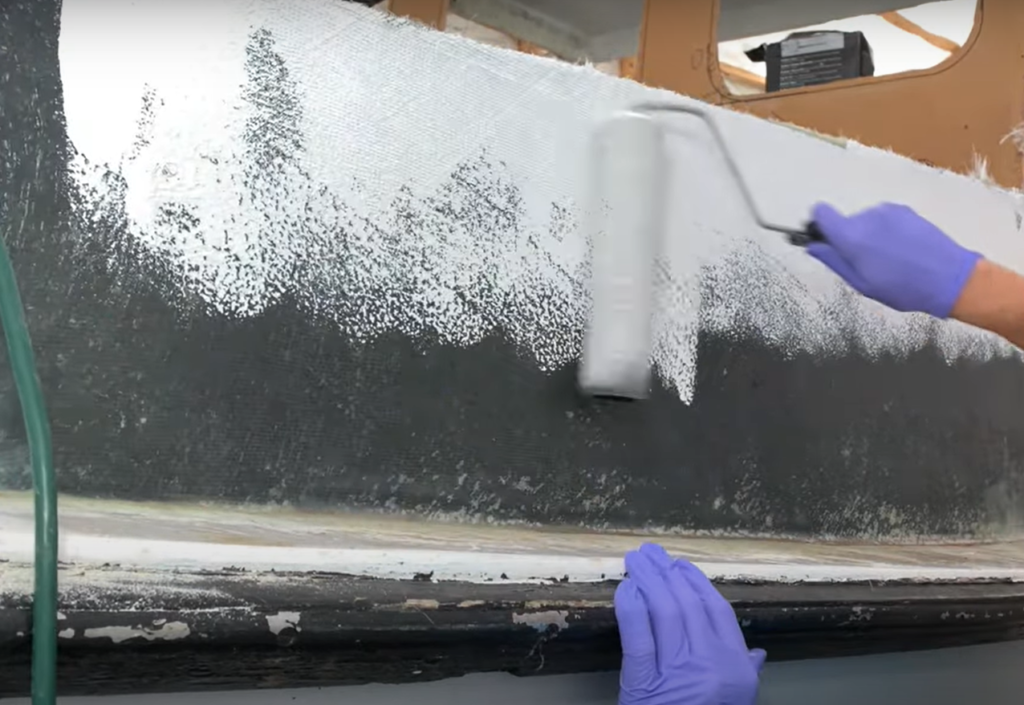
Here are the steps to follow:
Preparation
Preparation is the first and one of the most crucial steps in painting over a gelcoat. This stage involves a thorough cleaning of the gelcoat surface to ensure optimal adhesion of the paint. Begin by cleaning the surface with a mild detergent and warm water solution. Gently scrub using a soft-bristled brush to eliminate dirt, grime, and salt buildup. Thoroughly rinse with fresh water and ensure the surface is completely dry.
After sanding the surface, use a clean, damp cloth to wipe away any sanding residues. Allow it to dry completely. It is crucial to work in a properly ventilated space and to wear suitable safety equipment, such as gloves, a dust mask, and protective eyewear, throughout the entire process.Epoxy Primer
Applying an epoxy primer is the next step after preparing the gelcoat surface. Epoxy primer functions as a sealant, creating a solid foundation for paint adhesion while also safeguarding against water infiltration. For optimal results, select a marine epoxy primer of exceptional quality. Apply the primer evenly using a roller or brush, ensuring you cover all areas of the gelcoat. It’s important to avoid over-applying the primer, as this could create drips or runs that need to be sanded down later. After applying, allow the primer to dry according to the manufacturer’s instructions. After the primer has completely dried, gently sand the surface using 400-grit sandpaper. This will help to even out any rough spots and enhance the adhesion of the paint. Finally, use a clean, damp cloth to wipe the surface and remove any sanding dust before moving on to the next step: applying paint. [3]
Topcoat Paint Over Gelcoat
Following the preparatory steps and epoxy primer application, the next step is the application of the topcoat paint over the prepared gelcoat surface. Using a high-quality marine paint is crucial for achieving a durable and attractive finish.
Start by stirring the paint thoroughly to ensure an even mix of pigments and binders. To achieve a flawless finish, carefully apply the paint with a premium brush or roller, ensuring thin and even layers. This technique will help prevent any unsightly drips or sags. It’s generally advised to apply at least two coats of paint, ensuring each coat dries fully as per the manufacturer’s instructions before applying the next.
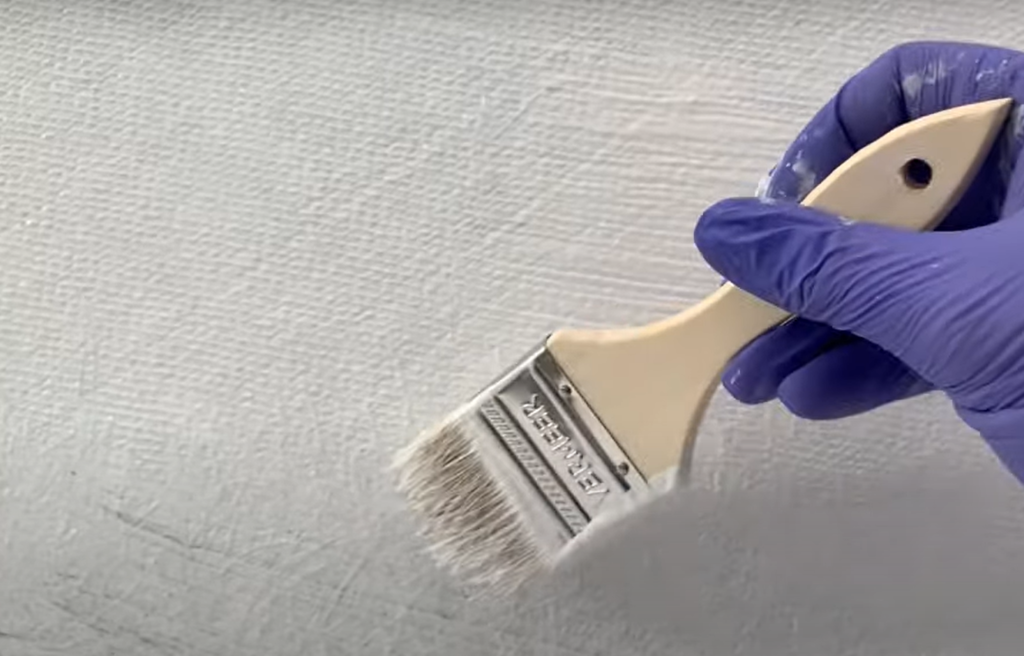
After the final coat dries, lightly sand the painted surface with 400-grit sandpaper to smooth rough spots. Remove the sanding dust by gently wiping it away with a clean, damp cloth. The process concludes with the application of a clear coat sealer. This extra layer enhances gloss, provides additional protection against UV rays and weathering, and extends the lifespan of your paint job.
Can I Paint Over Gelcoat?
Certainly, it is possible to apply a fresh coat of paint over a gelcoat. While the primary function of a gelcoat is to protect the underlying fiberglass from moisture damage, it also provides an aesthetic finish. Over time, gelcoat can dull, fade, or get scratched. In such cases, painting over it can effectively restore your boat or RV’s appearance. To ensure a successful and durable paint job, it’s important to follow the correct steps for preparation, priming, painting, and sealing. Always use high-quality marine products for gelcoat applications and follow safety measures. [4]
FAQ
Can you paint over a Fibreglass gel coat?
Yes, you can paint over a fiberglass gel coat. The process resembles painting over a standard gel coat. It entails several steps: meticulous cleaning, sanding, applying an epoxy primer for priming, using a top-notch marine paint for painting, and finally sealing it with a clear coat. The key point is to ensure you’re using marine-grade products designed for use with fiberglass and gelcoat surfaces. Furthermore, it is imperative to allocate sufficient time for thorough surface preparation. This step is crucial in order to achieve optimal adhesion and enhance the durability of the paint. Always remember to follow safety guidelines when undertaking such projects.
Will automotive paint stick to gelcoat?
While automotive paint can adhere to gelcoat, it is important to recognize that this should be seen as a final option rather than a primary one. Marine-grade paints are specially designed for flexibility and durability in harsh conditions that boats and RVs experience, whereas automotive paint is formulated for a less challenging and volatile environment.
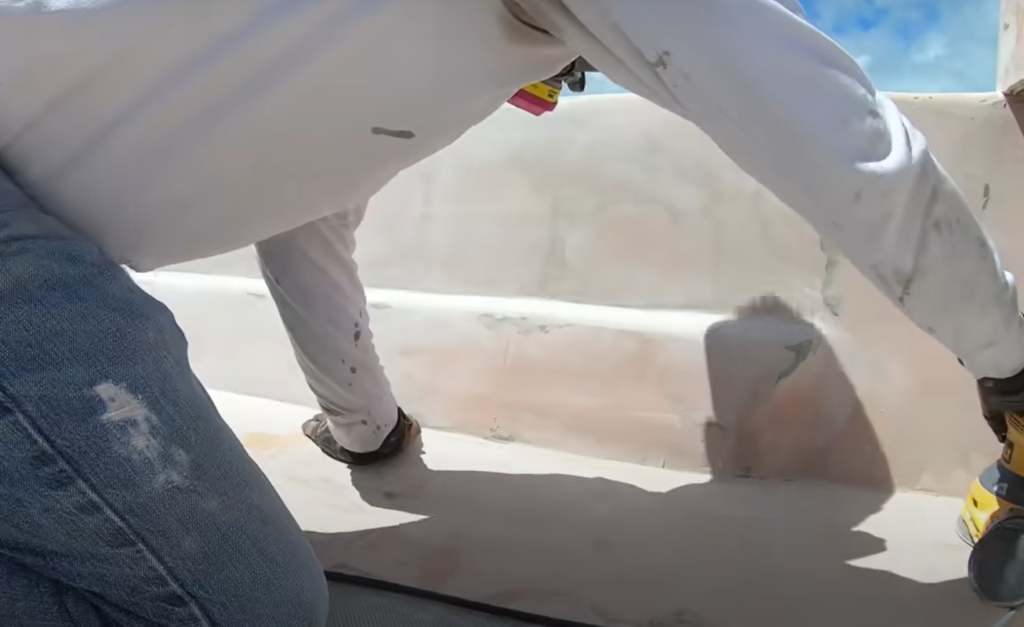
While automotive paint may look good initially, it may not withstand prolonged exposure to UV rays, salt water, and changing temperatures. When using automotive paint on gelcoat, follow proper preparation and application steps. This includes thorough cleaning, sanding, and priming to optimize paint adhesion and longevity.
Is gel coat paintable?
Absolutely, gel coats are paintable. However, to achieve a long-lasting, durable finish, it’s crucial to carefully follow the correct preparatory steps, including thorough cleaning, sanding, and priming. Using marine-grade paint designed specifically for gelcoat and other maritime surfaces is also critical to ensure paint adherence and longevity. In conclusion, the application of a clear coat sealer can amplify the glossy appearance of the finish, provide extra safeguarding against environmental factors, and prolong the longevity of the painted surface. Please always prioritize safety during this process by wearing appropriate protective gear. Remember, compromising safety is never an option.
Should I polish or paint gelcoat?
The decision between polishing or painting a gelcoat largely depends on the condition of your gelcoat and your specific needs. If your gelcoat is lightly scratched or faded, polishing may be sufficient. Polishing can remove minor imperfections and restore the gloss of the gelcoat, making it look almost like new. It’s a less labor-intensive process than painting and doesn’t involve applying any new layers to the surface.
However, if your gelcoat is heavily scratched, has deep gouges, or is extremely faded, painting might be the better option. Painting your boat or RV not only gives it a fresh new look, but also adds an extra level of protection against the damaging effects of UV rays and weathering. It’s more labor-intensive and time-consuming than polishing, but it could give you a more durable and long-lasting finish.
Whether you choose to polish or paint, remember to use high-quality products and follow the appropriate steps for the best results. Always follow safety procedures, wear the necessary protective gear, and ensure a well-ventilated work area.
Why do boats use gelcoat instead of paint?
Boats primarily use gelcoat instead of paint because of gelcoat’s unique properties that make it ideal for marine applications. Gelcoat, a type of polyester resin, is applied directly to the mold during the manufacturing process of fiberglass boats. This creates an exceptionally hard, smooth surface that is highly resistant to water ingress, UV damage, and chemical corrosion. It’s not just a coating, but a part of the fiberglass structure itself, hence providing superior protection. On the other hand, traditional paint simply adheres to the surface and doesn’t provide the same level of dimensional stability, durability, or longevity as a gelcoat.
Do you need to use a primer on a gelcoat?
Yes, using a primer on a gelcoat before painting is highly recommended. A primer serves as an intermediary layer between the gelcoat and the paint, helping to ensure proper adhesion of the paint to the surface. It also provides a uniform base for the paint, which can enhance the final appearance.
The primer should be carefully applied according to the manufacturer’s instructions, then allowed to dry fully before proceeding with painting. As with all steps in this process, safety precautions should be strictly adhered to, including the use of protective gear.Do you need to prime before painting over the gelcoat?
Indeed, it is essential to prime before painting over a gelcoat. Primer provides several benefits, such as smoothing out the gelcoat surface, offering an even base for the paint to adhere to, and enhancing the durability of the paint job. It acts as a bridge between the gelcoat and paint, ensuring excellent bonding. For the best results, it is recommended to use a marine-grade epoxy primer as it is specifically designed to work with gelcoat surfaces and marine paints.
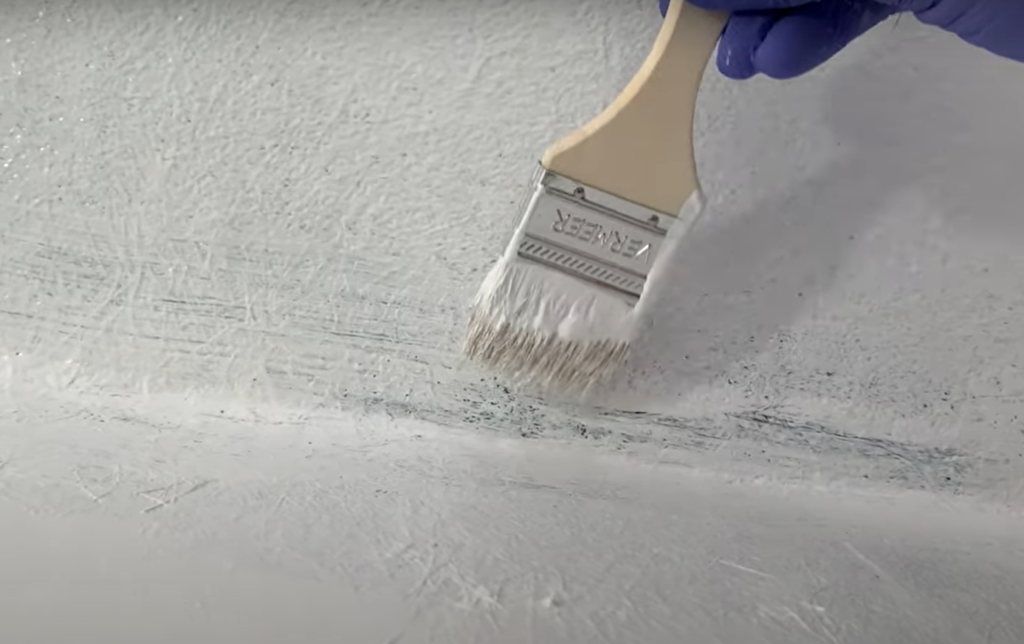
The primer should be meticulously applied following the manufacturer’s guidelines and given adequate time to dry before the paint application. Safety measures, including wearing appropriate protective gear and working in a well-ventilated area, should be strictly observed during this process.
Do you need special paint to paint over fiberglass?
Yes, a special type of paint is typically recommended when painting over fiberglass. Marine-grade paint is often the preferred choice as it is specially formulated to adhere to fiberglass surfaces and withstand the harsh conditions that boats and marine equipment are often subjected to. These paints are designed to resist UV rays, salt water, and extreme temperatures, thus providing a durable, long-lasting finish. It’s also important to note that before painting, the fiberglass surface should be thoroughly cleaned, sanded, and primed to ensure optimal paint adhesion. As always, safety measures, such as wearing appropriate protective gear and ensuring good ventilation, should be strictly observed during the painting process.
Will epoxy paint stick to the gelcoat?
Yes, epoxy paint can indeed adhere to a gelcoat, given that the surface has been properly prepared. Preparation includes thorough cleaning, sanding to create a rough surface for the paint to grip, and using a high-quality primer. Epoxy paint is a common choice for marine applications due to its durability and resistance to water and UV damage. However, it’s crucial to use marine-grade epoxy paint, which is specifically formulated to withstand the harsh marine environment. Remember to always follow safety guidelines, such as wearing appropriate protective gear and working in a well-ventilated space.
Is gelcoat Acrylic?
No, gelcoat is not acrylic. Gelcoat is a type of specialty polyester resin that’s formulated to create a high-quality finish on the surface of a molded part, like a boat hull. It’s specifically developed to be durable, water-resistant, and to withstand harsh weather conditions and UV exposure. Unlike acrylic, which is a type of plastic, gelcoat is made from polyester resin mixed with a series of hardeners and additives that give it its unique properties. However, it’s worth noting that, just like acrylic, gelcoat is also available in different colors and can be polished to achieve a high gloss finish.
Useful Video: How to Apply Gelcoat -Part one-
Conclusion
In conclusion, while gelcoat is the primary protective layer for fiberglass boats due to its superior durability, resistance to harsh marine conditions, and low maintenance, painting over gelcoat can offer a fresh, renewed look when it becomes dull or faded. However, the painting process requires careful preparation, including cleaning, sanding, and priming with a high-quality marine-grade epoxy primer. Specialized marine paint, such as marine-grade epoxy paint, is recommended for its strong adhesion to fiberglass and resistance to water, UV damage, and extreme marine conditions. Regardless of the choice between polishing or painting, safety procedures should be strictly adhered to throughout the process.
References:
- https://sdmarina.com/painting-over-gelcoat/#:~:text=Painting%20over%20gelcoat%20is%20practical,need%20to%20be%20repaired%20first.
- https://boating.guide/a-boat-repair-guide-to-painting-over-gelcoat/
- https://mycruiserlife.com/painting-over-gelcoat/
- https://paintanalyzer.com/can-you-paint-over-gelcoat/


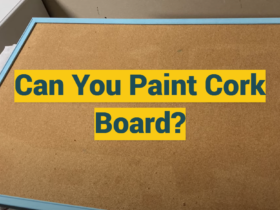
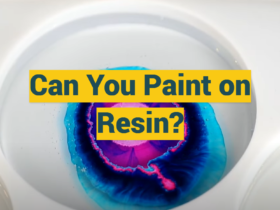
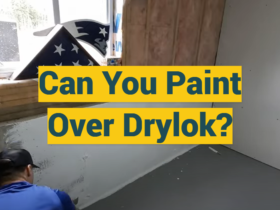
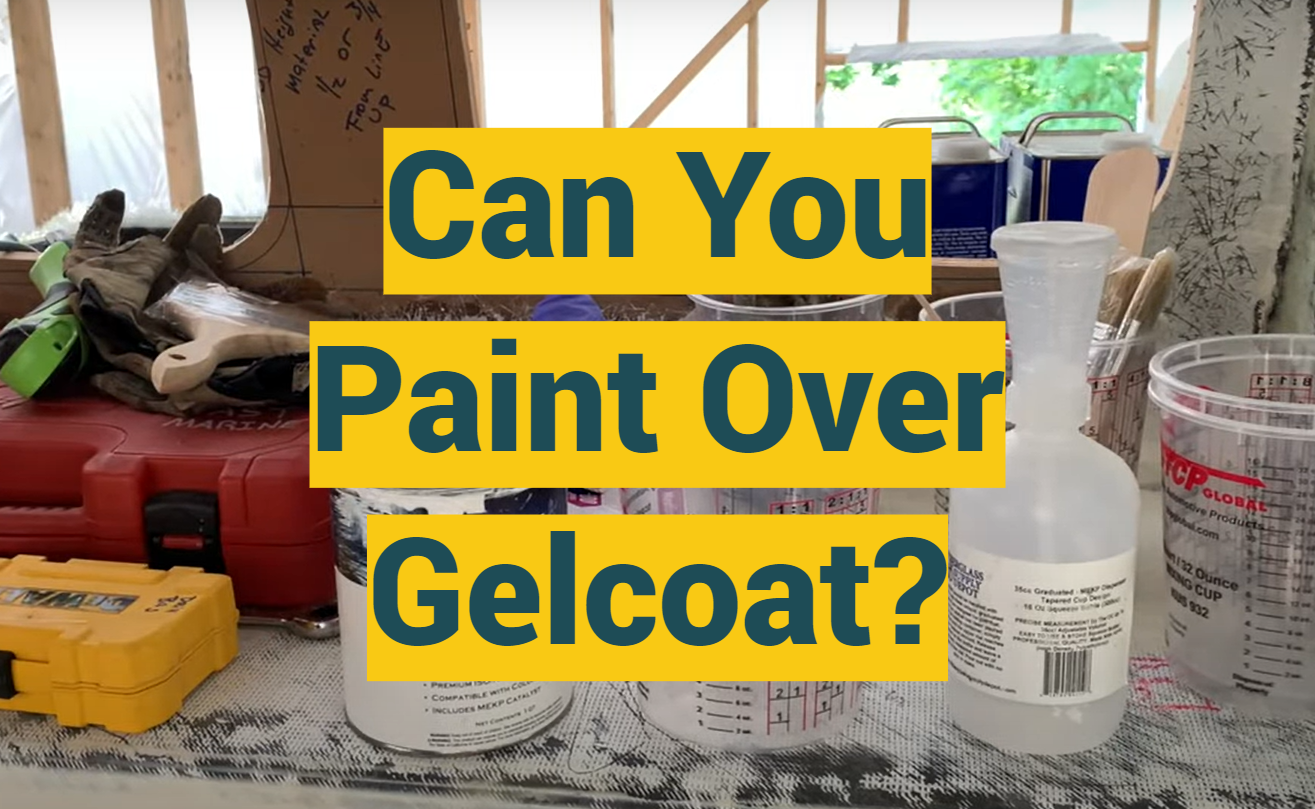




Leave a Review